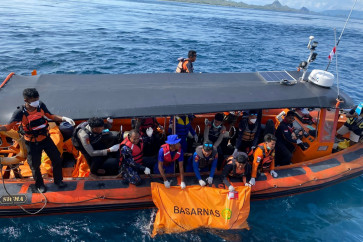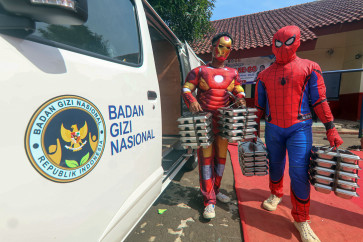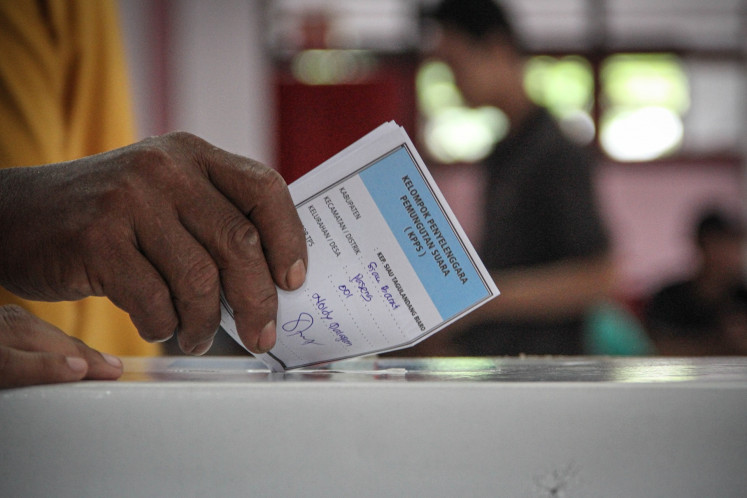Popular Reads
Top Results
Can't find what you're looking for?
View all search resultsPopular Reads
Top Results
Can't find what you're looking for?
View all search resultsIndonesia struggles to tackle drug-resistant tuberculosis
With the rising threat of drug-resistant tuberculosis (DR-TB), Indonesia, a country with the third largest number of cases, is finding itself in a tough spot to combat the disease
Change text size
Gift Premium Articles
to Anyone
W
ith the rising threat of drug-resistant tuberculosis (DR-TB), Indonesia, a country with the third largest number of cases, is finding itself in a tough spot to combat the disease.
Despite the country having provided medication for all kinds of tuberculosis for free, many patients have their treatment cut halfway as they become resistant to the drugs and recovery becomes more problematic.
Treatment for DR-TB is more difficult than regular TB as it requires different drugs — which are more costly and have stronger side effects. The treatment also takes longer — the drugs must be taken for up to two years, compared to the six months in regular TB cases.
“According to the most recent data from the Health Ministry, it is predicted that we have around 12,000 DR-TB cases per year. But only around 8,800 could be diagnosed. And only 75 percent of the diagnosed patients are fully treated,” Erlina Burhan, a pulmonologist from Persahabatan Hospital in East Jakarta told The Jakarta Post on Friday.
She said most of the DR-TB patients were TB patients who did not finish their six-month treatment or were not disciplined in taking their daily drugs during treatment. The TB bacteria get stronger and become resistant to the drugs.
DR-TB is the only airborne drug-resistant epidemic in the world and is responsible for nearly one-third of all deaths from antimicrobial resistance globally. Indonesia is third with the most TB cases, after India and China.
Treating DR-TB is very costly. Erlina said a patient with regular TB had to spend around Rp 1.2 million (US$86.20) for medication until they were healed. DR-TB patients need more kinds of drugs — more expensive ones and also daily injections.
“It may cost dozens of millions rupiah for two-year intensive treatment for DR-TB patients,” she added.
However, the ministry’s disease control and prevention director general, Anung Sugihantono, said although the government had covered treatment costs for DR-TB patients, it was still hard to reach out to all the patients.
“One of the obstacles is we can’t help them with their transportation costs; and they have to visit the hospital everyday [for two years] to receive the drugs and injections,” Anung said on Thursday.
Erlina said it was the main reason for many patients not wanting to undergo treatment because traveling to the hospital everyday was not compatible their work hours.
“Another obstacle is not every hospital provides DR-TB treatment for patients. So I hope more hospitals and health facilities will have it,” she said.
A recent report published by the Economist Intelligence Unit (EIU) revealed that DR-TB is on the rise with 558,000 new cases a year globally. It cited a major United Kingdom review on antimicrobial resistance that estimated the impact of an additional 40 percent of global TB cases becoming resistant to first-line drugs.
In this scenario an additional 75 million people would lose their lives to DR-TB between 2015 and 2050, with India, Nigeria, China, Indonesia and South Africa accounting for more than half of these deaths.
Cat Oyler, a global public health vice president from Johnson & Johnson Global Public Health, said countries with some of the fastest growing economies such as Indonesia, India, China and South Africa had been hit hardest by DR-TB.
“One of the biggest challenges in DR-TB is diagnosing and treating patients. Only one in three people with DR-TB are diagnosed, and only one in four people are treated. In effect, this means that there are approximately 400,000 people with DR-TB who don’t even know they have it.”
The EIU report, which was supported by Johnson & Johnson, also reported that DR-TB deaths — in a single year — will cost the global economy $17.8 billion in future gross domestic product losses. That means if nothing is done to solve it, it is estimated that DR-TB could cause up to 2.5 million deaths per year and cost the global economy $17 trillion by 2050.
The report also said while DR-TB posed a significant threat to global health security, efforts to fight it were acknowledged as under-resourced.
Erlina said Indonesia had the target to eliminate TB by 2030 so the approach to treat TB patients should not be business as usual.
“Doctors and health officials cannot just casually wait for patients to come to them. They have to proactively check them, the sources and ensure that patients will finish their treatment. TB patients who finish their treatment will reduce the number of DR-TB cases,” she said.










